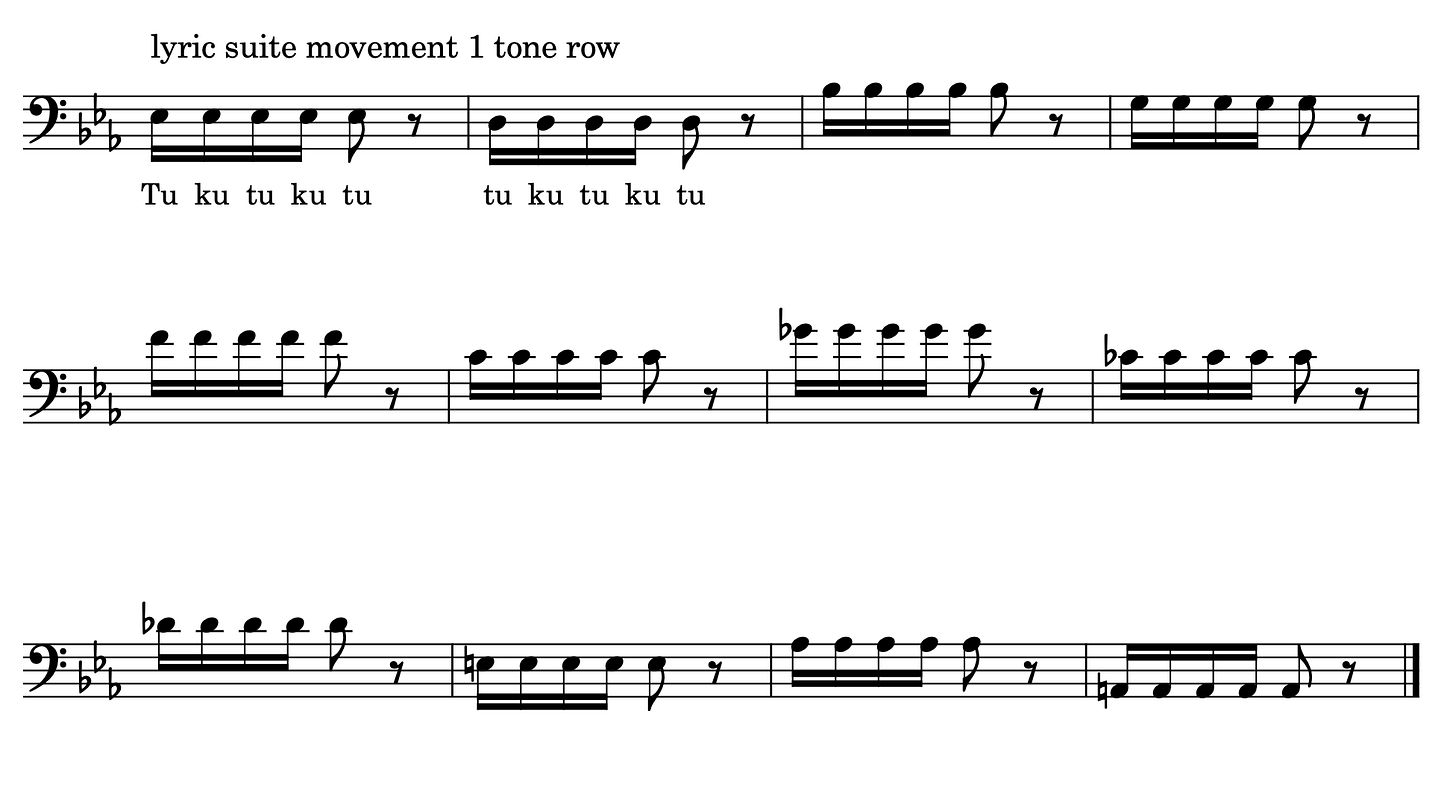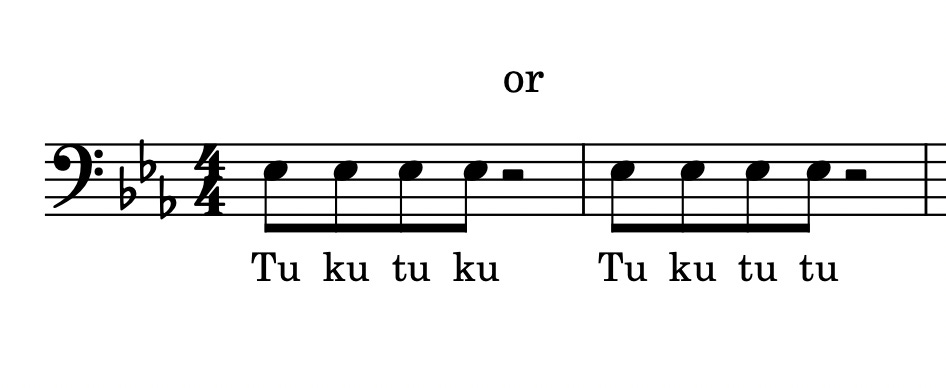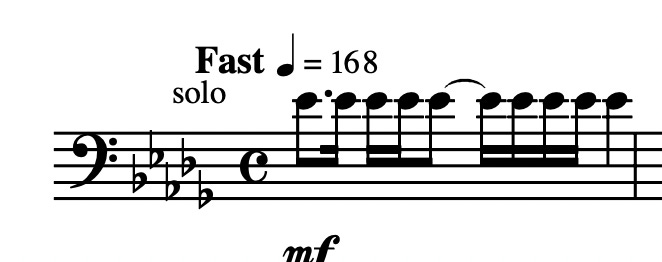Double Tonguing Part 4
teaching Jean-Baptiste Arban, Professor au Conservatoire Imperial de Musique, to swing
This post is part of a series largely geared towards trombone players. I’m also going to touch on a lot of tangentially related musical goodies.
If you are trombone-articulation curious, read on. Otherwise, sit tight, I’ll have plenty of non-trombone specific content in the weeks to come. No apologies for going so deep into a niche topic. My whole career could be described as going deep into a niche topic.
Read Part 1 Introduction
Part 2 Double Vs Doodle: Ultimate Smackdown
Part 3 Mastering Single Tonguing + Double Tonguing first steps
If you’ve been following along with parts 1, 2, and 3, and dutifully doing the exercises therein, you should have gained some basic facility with double tonguing.
“But Jacob”, you plead “my double tonguing sounds so square and harsh and even! How am I going to apply this to jazz or Brazilian music or whatever?”
Reader, hold my hand and take deep breaths. We are going to get there. It’s going to take time.
First let us return to where we left off, with diabolically simple exercise #77 from Arban’s Method for Cornet.
As I discussed in Part 3, Arban’s is useful and methodical. Let’s make it do our bidding.
Step 10: move your “tah” stroke back.
When I say “tah” the tip of my tongue is where my teeth meet the roof of my mouth.
So the first step is getting comfy moving the tongue just a bit further back into the oral cavity to create a more legato articulation.
Develop a nice even “da”-tongued exercise 77. Develop how? Why, brain-numbing repetition, of course. Start slow. Yeah it’s pretty dull. You can watch TV. I like Marvel movies with subtitles. When I was in college I would practice on a high floor and look out the window. Dave Taylor told me he played slow scales while he sat on the edge of the bed and watched baseball games.
Eventually it’s gonna be like this. Note that I start each group with a “ta” to get a clean attack. Medium tempo, medium volume.
Repeat with Arban’s exercises 78-84, getting familiar with the sensation of the tongue further back.
Step 11: Square-ass Swing 8ths
Return to exercise 77 and swing it at a medium tempo. Practice saying the syllables, swinging, away from the horn. Note the original is written as 16ths but you are going to say/play it as swing 8ths. Yeah it sounds corny. Run with it. Remember you are still taking baby steps. This is not the most swinging rhythmic phrase. It is quite squarely beginning on the beat and ending on the beat. You may want to exaggerate the swing feel, as well as trying a more even swing feel.
slow tempo
medium tempo
If you get tired of #77 you can now keep the rhythm but change the notes. Play it as a chromatic scale, an altered scale, or, a mode of limited transposition. Here it is as the tone row from Berg’s Lyric Suite movement 1. You can now extend the range of the exercise a bit.
Step 12: Jumpin’ at the Woodside lick
For each of these horrid Arban’s exercises there are corollary tunes, riffs, and licks which contain similar elements but contain actual, you know, music.
I am particularly fond of pairing bebop tunes, as well as other tunes with streams of 8th notes, with these exercises. For one thing it’s good to learn a lot of tunes. For another, bebop tunes are shorter than transcribing solos, but longer than the exercises. They contain a great deal of rhythmic variety, sometimes more than you find in bebop solos themselves. You’ll find phrases on the beat, off the beat, over the barline, incorporating triplets, etc. This will prepare you for being able to tongue any rhythm.
Here’s a lick which pairs nicely with exercise 77. It’s a Basie riff that the trumpets play at the end of many versions of Jumpin’ at the Woodside. It can be played at nearly any tempo.
At this point you want to get quite comfortable with swinging on a repeated note. You can imitate J.J. Johnson, who often does this at fast tempos. Check out “When The Saints Go Marching In” from “Touch of Satin”, around 1:51.
You can also just get used to the sensation of long strings of 8th notes on the same pitch. Think of yourself as a drummer and this is your ride cymbal.
In this 1958 solo by Al Grey, live with the Basie Band, an example of virtuoso uptempo non-J. J. influenced, swing-style trombone playing, you can hear a lot of single note riff licks which are great for working on this.
Step 13: Ending on upbeat
Now you can start to get comfortable with ending phrases on an upbeat. To do this you can adapt Arban’s 77 like so. Sing first. You should be able to end with both a ka syllable and ta/da. I use them interchangeably.
Step 14: Beginning on an upbeat
Now you are getting more of a sense of the variety of rhythmic phrases that you will want to use in actual playing. Practice starting these with both ka and ta.
Step 15: Become comfortable with repetitions on one note.
There are quite a lot of rhythmic devices you can do with double tonguing on the same pitch. You can practice groupings of 3. You can practice the rhythms of bebop tunes but all on one pitch. You can learn some Balkan tenor horn rhythmic accompaniment patterns. I’m going to get into more detail with Balkan patterns in a future post.
Here’s the lick from my piece “Digression on the History of Jews in Black Music” from “The Heavens”. I tongued it
Ta ga-da-ga-da ga-da-ga-da
Step 16: Pairs of notes
Arban’s #81 features pairs of notes moving up the scale. Adapt this to swinging 8th notes. Corollary tunes to practice are “Mr P.C.”, although you might want to transpose it to F minor for the trombone, “Lester Leaps In”, the first section of “Boogie Stop Shuffle”, and “Shadrack”.
Step 17: Short bursts of single notes
The drill: Translate Arbans #87 to 8th notes, be comfortable saying/singing first, start slow, use alternate positions, move slide ahead of tongue, each group of 5 is Ta-ka-da-ka-da.
This one is going to take a while to get the slide coordination, which is orders of magnitude more difficult than the previous step. Stay on this one, and it’s short sequence of notes, before tackling longer streams. At this point you can start working on easy bebop and bebop-ish tunes that have streams of 3-6 notes in them. Here’s some.
Easy
Rhythm-a-ning
Cottontail
Mr PC
Boogie Stop Shuffle (1st section)
Lester Leaps In
Solar
Blue Trombone
Shadrack
Step 17: longer bursts of 8ths
The following tunes have longer streams of 8ths in them. Pair with Arban’s #88-89.
Medium
Oleo
Now’s the Time
Ornithology
Anthropology
Dahoud
Crazeology
Moose the Mooche
Au Privave
Hackensack
Take the Coltrane
Four
Scrapple from the Apple
A-Leu-Cha
Airegin
Recordame
These tunes have particularly long streams of 8ths and/or triplets.
Hard
Donna Lee
Confirmation
Eternal Triangle
Voyage
Gingerbread Boy
Freedom Jazz Dance
Boogie Stop Shuffle (2nd section)
Inner urge
Yes and No
Two Bass Hit
Be-bop
Many players who consider themselves swinging single tonguers try a little double tonguing and find it doesn’t swing in a way they like. Sometimes people say “I couldn’t make it work.” Adapting the “paired” articulation to swinging music is a challenge. But this is what musicians do, melding awkward paired techniques to rhythm, whether it’s the paired up and down strokes of a pick, right and left strokes of the drumsticks, or right and left feet of a tap dancer. Repetition breeds familiarity. Don’t expect instant success. You will get results in a few months.
next up:
Adapting Coltrane’s “Isorhythm” technique to paired tonguing practice








